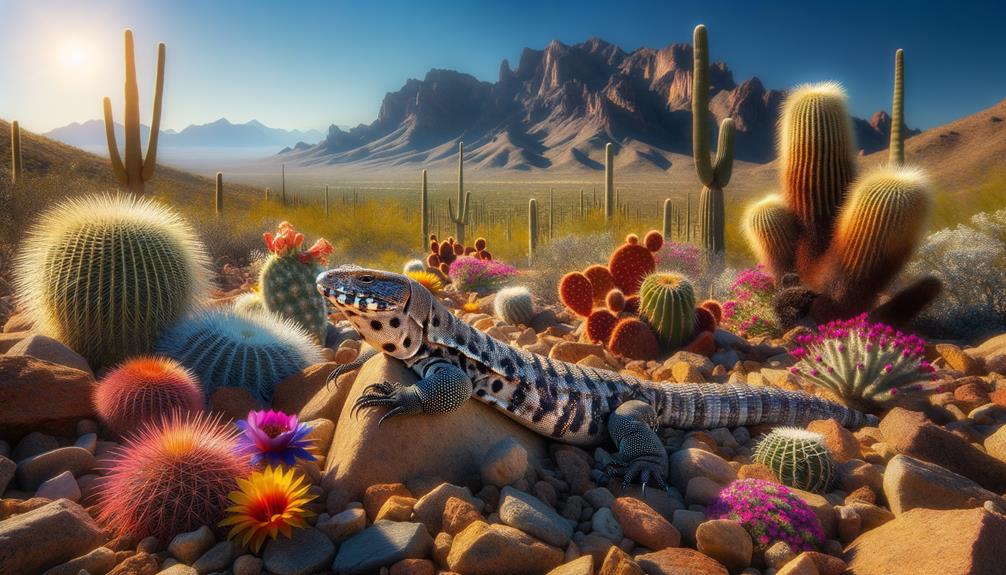Exploring the Atacama Desert felt like venturing into an alien landscape. The Salar de Atacama‘s vast salt flats sparkled like a mirror, leaving me awestruck. In Valle de la Luna, jagged rock formations sculpted by wind and water resembled a lunar landscape. I marveled at the wildlife adapted to the harsh conditions, like vibrant flamingos in lagoons and vicuñas roaming the high grasslands. In San Pedro de Atacama, I immersed myself in rich cultural experiences, uncovering ancient petroglyphs and savoring traditional cuisine. Hiking Moon Valley and witnessing the steam fumaroles of El Tatio Geysers was an otherworldly experience. There’s still so much to uncover in this arid wonderland.
Key Takeaways
Explore the surreal landscapes and shifting light of Valle de la Luna, a geological wonder that’s out of this world.
Witness the breathtaking beauty of Salar de Atacama, where a vast expanse of shimmering white salt flats stretches as far as the eye can see.
In the heart of El Tatio Geysers, marvel at the world’s highest geothermal field, a natural phenomenon that’s both awe-inspiring and humbling.
Venture into the natural habitats of vicuñas and flamingos, observing these incredible creatures up close and personal.
Immerse yourself in the rich cultural heritage of San Pedro de Atacama, where ancient traditions and modern charm blend seamlessly together, and savor the local flavors of traditional cuisine.
Geology of Atacama
As I venture into the Atacama Desert, I’m struck by its vast salt flats, like the Salar de Atacama, which stretch out in dazzling, crystalline expanses. These salt flats are remnants of ancient lakes, now transformed by the desert’s harsh, dry climate.
In the heart of this desert lies the Valle de la Luna, a name that translates to ‘Valley of the Moon.’ Here, the landscape’s surreal, lunar-like geological formations, carved by wind and water erosion, evoke a sense of otherworldly freedom. The towering dunes and jagged peaks are a testament to nature’s artistry over millions of years.
The Atacama Desert’s unique arid climate is shaped by its location, bordered by the Andes Mountains to the east and the Cordillera de la Costa to the west. The seismic activity along the boundary of the Nazca and South American tectonic plates further shapes this region, adding to its dramatic and ever-changing topography. With each step, I uncover the intricate tale of Earth’s geological history.
Unique Landscapes
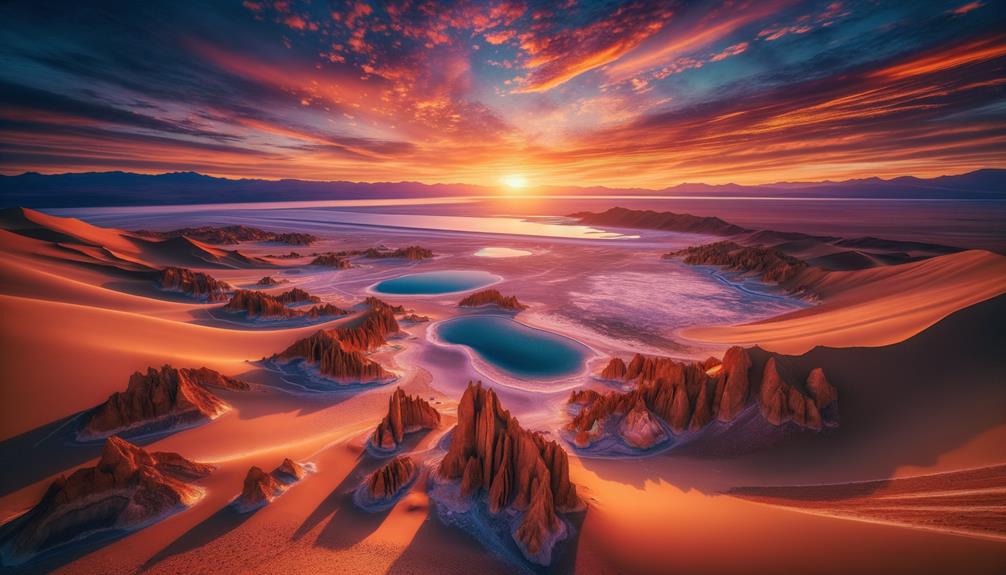
Amid the Atacama Desert’s striking landscape, I stumble upon surreal vistas that seem ripped from the pages of a science fiction novel. Valle de la Luna, with its jagged rock formations and shifting light, resembles an extraterrestrial world, while the nearby Valle de los Muertos has an equally otherworldly aura. The vast expanse of the Salar de Atacama stretches out before me, its shimmering white salt pans producing an unsettling crackling sound in the heat.
As I ascend higher, El Tatio Geysers, the world’s highest geothermal field, leave me awestruck with their impressive steam fumaroles. Here, at nearly 14,000 feet, nature’s raw power is on full display, framed by towering mountains and snow-capped volcanoes.
In contrast, the Lagunas Altiplanicas burst with vibrant color. These high-altitude lagoons, nestled among volcanic peaks, dazzle with their deep blue and green hues. The sight of flamingos wading through these pristine waters adds a touch of elegance to the harsh desert environment.
Each unique landscape in the Atacama tells a story of extremes, inviting exploration and promising limitless freedom for those brave enough to venture into its arid wonders.
Adapted Wildlife
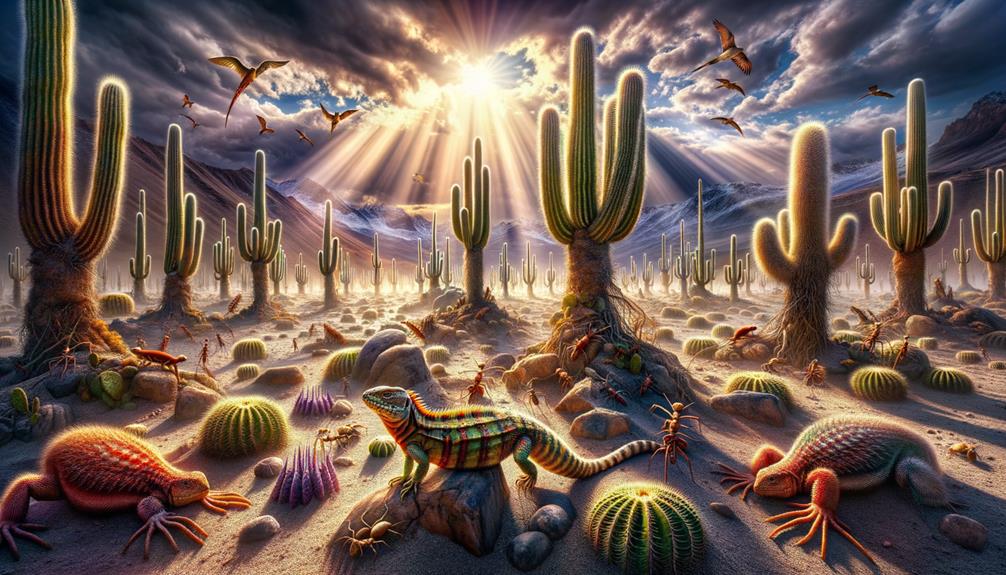
As I delve into the Atacama’s breathtaking landscapes, I’m constantly amazed by the incredible array of wildlife that has adapted to thrive in such an unforgiving environment. The Atacama Desert, known for its extreme aridity, is home to species that have ingeniously adapted to its harsh conditions.
Vicuñas roam the high-altitude grasslands, their soft wool prized for its warmth and rarity. Near the Puritama Hot Springs, I spot resilient Chilean rose tarantulas traversing the rocky terrain, perfectly adapted to the desert’s extremes. The Atacama Desert toad, another hardy resident, has evolved to withstand the region’s severe temperature fluctuations and scarce water supply.
Flamingos, with their striking pink plumage, gather at Laguna Cejar, feeding on brine shrimp and algae in the saline waters. As I gaze upwards, I catch sight of the majestic Andean condor soaring over the craggy peaks near Lascar Volcano. This magnificent bird, with its impressive wingspan, plays a vital role in the ecosystem as a scavenger.
Each of these creatures embodies the spirit of resilience and adaptability, making the Atacama Desert a living testament to nature’s ingenuity in overcoming adversity.
Cultural Highlights
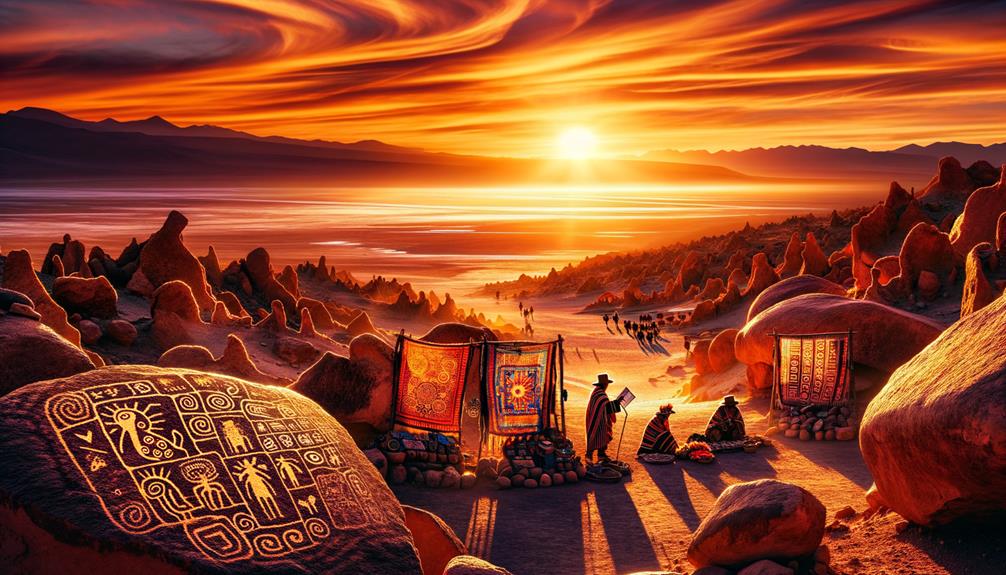
Nestled within the Atacama’s stark beauty, I stumble upon a rich tapestry of cultural highlights that reveal the ancient and enduring spirit of the indigenous Lickan-Antai people. San Pedro de Atacama, the region’s cultural hub, is steeped in Atacameño history and traditions. Here, the Pukara de Quitor, an archaeological site dating back to the 12th century, stands as a testament to the engineering prowess of the Lickan-Antai. The fortress-like structure, made of stone and adobe, offers a glimpse into the past, where ancient battles and daily life unfolded.
The vibrant celebration of Inti Raymi, the Inca sun festival, showcases the community’s deep connection to ancient astronomical knowledge and rituals. I witness colorful ceremonies that honor the sun, the lifeblood of this arid land. The region’s rock art and petroglyphs, etched into stone by ancient hands, tell stories of survival and spirituality.
As I wander through villages, the adobe architecture and colorful textiles catch my eye, each piece a reflection of the Atacameño’s artistic heritage. Traditional cuisine, rich with native ingredients, offers a taste of their culinary legacy. From medicinal plant uses to weaving demonstrations, the cultural richness of the Atacama is an experience that resonates deeply.
Adventure Activities
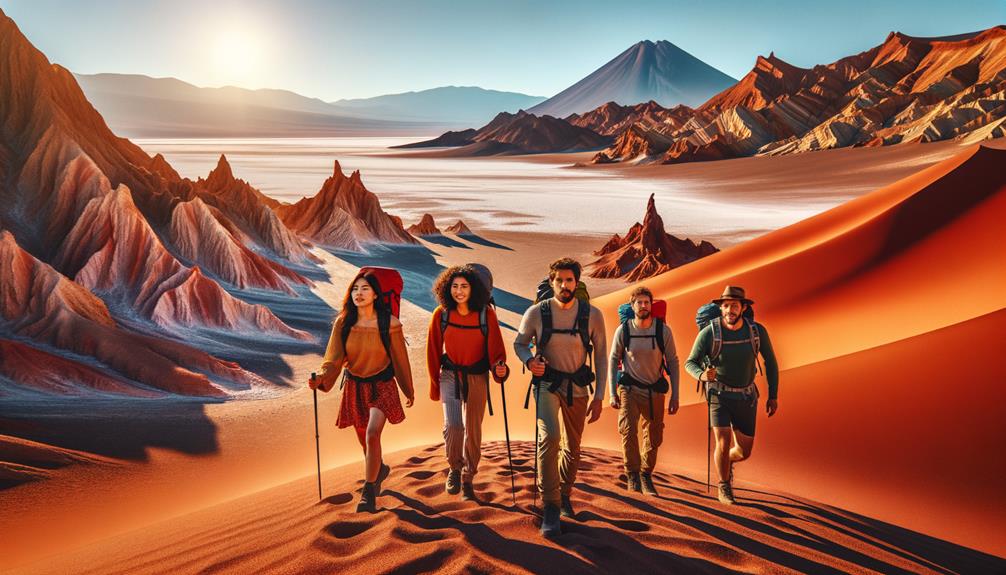
As I ventured away from the vibrant cultural tapestry of the Lickan-Antai, I embarked on an adrenaline-packed journey across the Atacama’s dramatic landscapes. With over 40 diverse explorations to choose from, I opted for the Kari expedition, navigating the winding Kari ravine and witnessing the desert’s diverse terrain sculpted by water erosion.
Next, I explored the rocky cactus valley of Guatín, where a single night’s acclimatization allowed me to marvel at the clear, shallow river cutting through the landscape. The Matancilla trek offered breathtaking panoramic views of the Arcoiris Valley and opportunities to spot guanacos.
| Activity | Highlight | Difficulty |
|---|---|---|
| Kari Expedition | Winding ravine | Moderate |
| Guatín Exploration | Rocky cactus valley | Intermediate |
| Matancilla Trek | Panoramic views, guanacos | Moderate |
| Tatio Geysers | High-altitude geysers, wildlife | Challenging |
| Moon Valley Hike | Otherworldly landscape | Easy |
As I walked through the Cordillera de la Sal, I felt as though I was on another planet. The Moon Valley’s surreal landscape was nothing short of breathtaking. As night fell, I gazed up at the pristine night skies, pondering the celestial wonders of the Atacama Large Millimeter/submillimeter Array. Finally, exploring the Tatio geysers at nearly 14,000 feet, I encountered vicuñas, foxes, and flamingos, completing an unforgettable adventure in this natural wonderland.
Best Visiting Times
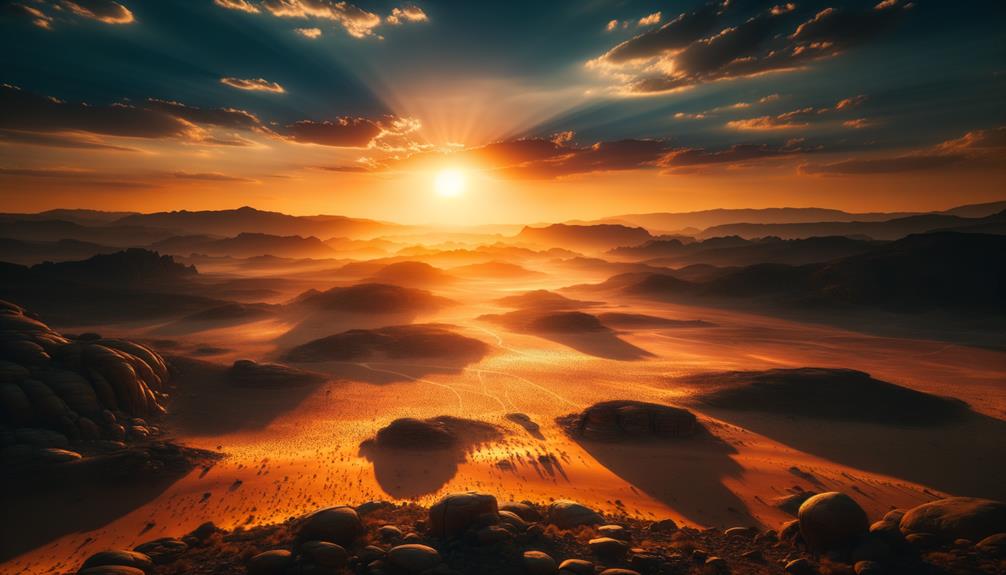
When is the best time to visit the Atacama Desert? The Atacama offers a unique experience year-round, but the ideal time to explore this arid landscape is from April to September. During these months, the desert is at its driest, with clear skies and comfortable temperatures, making it perfect for hiking through Valle de la Luna, which offers breathtaking panoramic views.
If you’re fascinated by the night sky, visiting during the fall and winter seasons is a must. The crystal-clear nights provide an unparalleled stargazing experience. Imagine lying back under a blanket of stars, the Milky Way stretching out above you in stunning detail.
In the spring and summer, from October to March, the desert transforms into a colorful canvas as wildflowers bloom, bringing warmth to the arid landscape. For those seeking adventure and relaxation, la Explora offers luxurious stays, blending comfort with the thrill of the desert.
Don’t miss the geothermal field near El Tatio, best visited in the crisp morning air. Timing your trip around the winter solstice in June allows you to explore the Tropic of Capricorn, adding a touch of geographical magic to your journey.
Frequently Asked Questions
What Is Famous About the Atacama Desert?
The Atacama Desert is renowned for being the world’s driest region. Its breathtaking salt flats, otherworldly landscapes, and exceptional stargazing opportunities make it a paradise for adventurers. This unique environment also supports an array of fascinating wildlife, adding to its irresistible charm.
When Was the Atacama Desert Discovered?
The Atacama Desert’s European discovery dates back to 1536, when Spanish conquistador Diego de Almagro arrived on the scene. However, indigenous groups like the Lickan-Antai had already called this arid region home for thousands of years prior to European contact.
What Observatory Can Be Found in the Atacama Desert?
When I visit the Atacama Desert, I can explore three world-class observatories: ALMA, the Very Large Telescope, and APEX. The desert’s incredibly clear skies make it an ideal spot for stargazing and learning about space. The Atacama’s unique combination of landscapes and celestial wonders makes it an unforgettable destination.
Is the Atacama the Driest Place on Earth?
The Atacama Desert is indeed the driest place on Earth, with some areas receiving no rainfall for hundreds of thousands of years. This extreme aridity creates a unique and fascinating environment that’s ripe for exploration and study.



